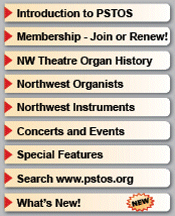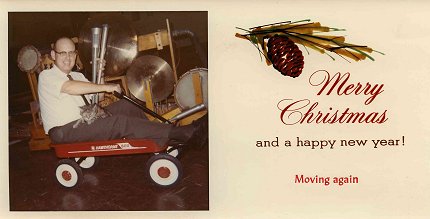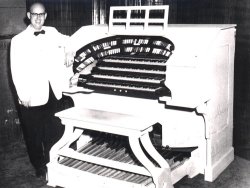


Bill Blunk (1924-2003)
The following notes are from PSTOS members, Jim and Shirley Clausen via the Theatreorgans-l Internet mailing list, April 1999:
Chapter 2
Chapter 3
Chapter 4
Chapter 5
Back to the Northwest organists page
He has since donated this magnificent organ to the Columbia River Organ Club, where it has been in
storage for several years. But just within the past month we have finally found a home for it and will be renovating and installing it in the Hollywood Theatre here in Portland."
"Bill has had an exciting and varied career as an organist -- since we have known him, he was organist for several years for the Portland Trailblazer National Basketball team, as well as organist at Uncle Milt's Pipe Organ Pizza Company. Now retired, he still plays regularly at a retirement center, purely for the pleasure of doing so. Needless to say, he is eager to see the Marr & Colton up and playing again, as we all are!"
Jim and Shirley Clausen

Bill Blunk's Christmas card. Courtesy Bob Markworth
From a May 15, 1999 interview with Bill by Bob Hohlbauch published in several parts in the Columbia River Organ Club Clarion newsletter: August - December 1999:
A Working Organist
Bill Blunk was a Founding Member of CROC, and in recognition of his contributions to CROC and to the world of the theatre organ in general, also an Honorary Member. He donated the large 5/24 Marr & Colton Theatre Pipe Organ to the Columbia River Organ Club. ![]() Editor's Note: This instrument was recently sold after attempts to find an appropriate Northwest venue were unsuccessful.
Editor's Note: This instrument was recently sold after attempts to find an appropriate Northwest venue were unsuccessful.
Foreword
When I approached Bill Blunk to ask him for an interview on his career, he told me he did not consider himself a concert artist, but a working organist. Quite a body of work it turned out to be! I had originally planned only one article, but Bill's life was so interesting, I felt it more appropriate to make it a series so I can properly cover this remarkable career.
Chapter 1
Bill Blunk was born in March 27, 1924, the youngest of four children. When he was about 10 or 11 years old he became interested in music when his grade school teacher would play classical music for the class on the phonograph. He fell in love with classical music. His father was a captain of the city fire depart who lost his life in the line of duty when Bill was 10 years old. He had 3 older sisters who had taken piano lessons. At about 12 years old he wanted piano lessons but his widowed mother could not afford them. But he did learn piano by watching his mother play and copied it. He was soon able to play ragtime and other types of music. His mother said that if he wanted lessons, he would have to earn the money for them. He got a job in a grocery store and his piano lessons were a dollar a week, from a gentlemen who lived right across the street. This made it difficult because his lesson was on Thursday, and every Wednesday Bill would "practice like hell!" The rest of the week he was playing things out of books he had no idea what it was, he just liked music. Since the teacher lived just across the street, he knew how much Bill was practicing. He told Bill, "If you would practice at least three or four more days, you would really have them down pat." Bill went through the classical type of learning to play the piano. He had finally worked up to playing sonatas and parts of concertos by the time he got to college, but he said the organ just took over.
Bill got interested in organ when he was about 15 years old. His mother would sometimes ship him off to Chicago to stay with his oldest sister. Every few weeks she would take Bill down to the Loop and they would go to the matinee at one of the many theatres. At each show, the great organ would come up out of the bowels of the theatre and play, much to Bill's delight. He recalls that he probably heard Jesse Crawford during this time; these were the years that
Crawford was playing in theatres. Bill had heard the pipe organ in his church, but it was nothing like the organ in the theatre -- he quickly fell in love with the popular style of
playing. Hearing the marimba from one side of the theatre, then a cymbal from the other side, he just couldn't believe it! The organist in his church had been in the circuit
playing theatre organs in the early twenties, and it wasn't long before he and Bill made contact. Bill went to school with the organist's daughter, a very good pianist. Later, in
the early forties, when Bill had an organ, he would come to the church organist's home and they would have a great time playing together. Bill felt he had learned a great deal
from this man, who was, in effect, his mentor.
The husband of a friend of Bill's mother was one of the better piano tuners in the city, and also happened to have, in his home, one of only two Hammond organs in the city at that time. Bill hounded his mother until she got them an invitation to the man's house; he very quickly became good friends with the piano tuner. As a result of this acquaintance, after Bill had gone to Indiana State Teachers College, he transferred to Chicago College of Music, in large part because Dr. William Braid White taught there. Bill notes that this is the man who "wrote the book" on piano tuning. It was because of him that American Steel and Wire began
making piano wire; before the war Germany had been making all the piano wire. He was also the one who got all the nations to agree to the A=440 standard in the early part of the 1900's. He was also a mentor while Bill was learning to be a piano tuner. Bill graduated with a diploma in Pianoforte Technology and Allied Arts. To earn this diploma he studied tuning of both pianos and organs; his textbook was Dr. William H. Barnes' well-known book The Contemporary American Organ.
Bill can't quite remember when he first played a theatre organ; he had played organs in churches. His first organ was an Everett Orgatron which he purchased from Ball State Teachers College. (Bill says the pneumatic action of that organ was so slow, he could play the 12th Street Rag, jump off the bench and go and back and listen to it!) He thinks he was about 19 or 20 before he got his hands on a real theatre organ. He had owned several makes of electronic organs, but never cared for the electric/electronic Wurlitzer. He could not understand why, when they had all this talent building theatre pipe organs, they didn't apply some of this talent to the design of the electronic instruments. He bought a couple of organs from De Paul University, where he worked for a few years. The music department was replacing the pipe organs with the early electric Wurlitzer organs. One of the instruments he purchased from De Paul was his first Kimball; a 6-rank pipe organ for just $50. A lot of organs in those days were very cheap, if you could get to them before they were thrown into the alley to be hauled away. Barton organs were popular in the Chicago area, but Wurlitzers were favored in Terra Haute; Bill had thought about buying one of these, a 3/7 Barton that was in Terre Haute's largest theatre, but by that time he had moved to the west coast. This was a period when theatres still had organs in them, but most of the theatres were closed up and you couldn't get to the organs. The few you could get to would be full of ciphers and other problems.
His first "professional" jobs didn't pay. He would play for the Kiwanas Club pancake feed and bring his own organ! Pay was the pancake breakfast - anything to play before people. Bill did a lot of that. He played fairs, particularly for horse shows where he played for the different acts. And at the fairs he usually got paid. At the Wigwam Skating Rink in Terra Haute, a woman played the Hammond and Bill often listened to her play in the strict rhythm required for skating. Finally, he got acquainted with her, and over the following months he would sometimes play the melody or reach over her shoulder and add to it. She had been playing seven days a week, and finally asked Bill if he would take over on Sundays. He was thrilled! He played Sunday afternoons and evenings for two weeks, then the woman quit and Bill was the regular organist for the next four years while he was going to college.
As soon as he was out of college, Bill was snapped up by Wilkings Music store in Indianapolis, the Steinway dealer for that area. After a couple of months at this job, he was the one they sent out to tune pianos for all the concerts.
In the late 1940's Bill bought a little 2 manual, 4 rank Wurlitzer with all the traps from a theatre in Astoria; he only paid $250 for it and they were glad to get rid of it! They wanted the space to store stuff in. While the owner of the theatre was showing Bill the organ, she noticed the holes on top of the Wurlitzer tremolos and exclaimed "Oh, my goodness, someone has stolen all the pipes from those!" Bill thinks that is one reason he got it cheaper because she thought half of it was missing. Bill not only installed the organ, he dragged it back and forth across the United States! Bill thinks this may have been the first real theatre organ he played.
Bill came to Oregon in 1952 when he moved to the Astoria area where he had family; he moved to Portland in about 1960. For a time he owned a roller skating rink in Astoria because that was where you could put a pipe organ (later on in they put them in pizza parlors). When he first bought the 5-manual Marr and Colton it was shipped to Astoria and installed in his roller rink for about a year or two until he moved to Portland.
The first concert on the M & C after he got it installed featured Don Baker as the artist. That was the year that the Puget Sound Theatre Organ Society was started. Bill was the President and Leonard was the Secretary/Treasurer/Vice President. They had their first meeting on the Marr & Colton in Astoria and Bill suggested the name Puget Sound Chapter as he thought people would associate it with the entire Northwest. Bill gave up the chairmanship the next year, since most of the members were in Seattle. Under the guidance of Dick Schrum, the chapter incorporated and joined the national ATOS. Unfortunately when they talk about that chapter they never start with its actual beginnings in Astoria, they always begin with the next year.
In another of his many enterprises, Bill put together a band that played on Fridays for the American Legion and on Saturdays for the Elks in Astoria. He had a large Thomas organ, with a piano alongside. The other instruments were trumpet, saxophone and drums. At the Elks there was also a little electronic organ contained in two or three boxes. Everything, including the bench, folded up into the cases. He played at the Elks for nine years, driving from Portland to Astoria and back every weekend after his move to Portland in about 1960. When he started playing at the Portland Airport in the 1960's, he quit the band; the band continued on for a couple of years with an accordion substituting for the organ. Bill notes that in those days, when the weather was good, some of the Elks would fly their own airplanes down to go to the dances at the Elks because that's where the best band around was playing at that time.
Bill's job at the airport was to play in the Port West Dining Room which was owned by American Airlines. This was strictly a crystal and silver operation, very high class. He played there for quite a few years. American Airlines supplied food for nearly all the airplanes out of Portland. Since their corporate structure required a head of each department, Bill became the head of the Music Department. The nice thing about this was that Bill had all these perks -- he could fly anyplace he wanted (he could fly roundtrip to Hawaii for $21, stay in the American Airlines hotel for just $7 a night, fly to Europe and back for only $121). During this period he travelled to Spain, Germany, Holland, Scandinavia, England, and many other places. Since he only played four days a week, he would often fly to Hawaii for the remaining three days.
He was still playing at the airport when the owners and operators of the Buckaroos hockey team came to Portland. (They flew in and out, but the players were relegated to riding busses.) They often stopped on their way through to enjoy a nice meal at the airport, where Bill was playing his usual very happy, low key music, and one day they asked him if he would be interested in playing the organ at the Coliseum. The organist then playing at the Coliseum was close to 90 at the time, and they weren't sure how much longer he would last. In addition to paying him for each game, they offered Bill a free pass and a place to park, just to show up with his music and sit over in Section 4 (the organ was in Section 7) and be there just in case the current organist should "fall off the bench". Eventually, Bill was hired by the Buckaroos hockey team. He worked for them for about two or three months, then when Christmas time came along, he asked the owners if he could go to Astoria to spend Christmas with his family. Well, Bill did go to Astoria for the holiday, but as soon as he returned to Portland, the Buckaroos called, and he immediately went to work, only missing the first day because he was in Astoria. Bill then played for the Buckaroos until the Trailblazers basketball team came on the scene.
About this site © PSTOS, 1998-2004
